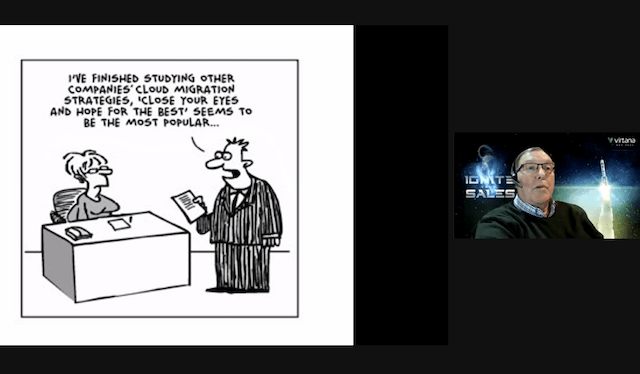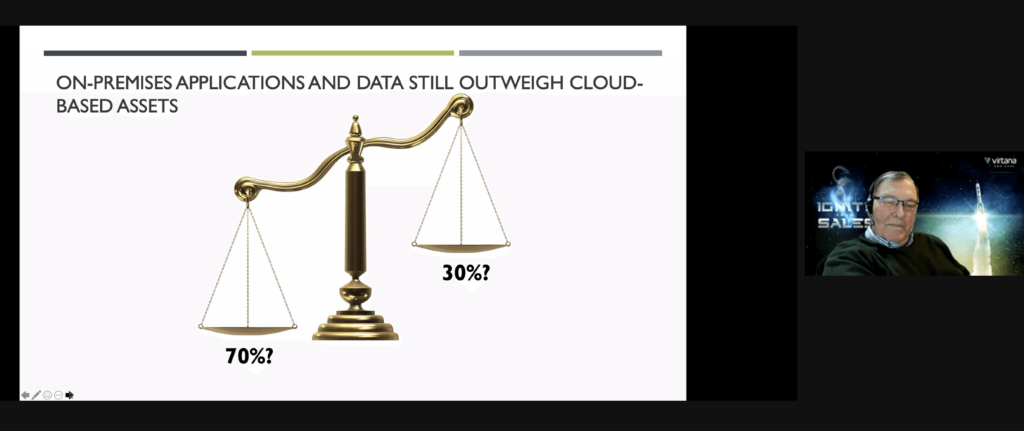The annual sales kick-off (affectionately known around Virtana as SKO—pronounced as a one-syllable word) is always a great event. Usually, it is a chance to bring the entire team together in one place to catch up, share war stories, and get jazzed about where the company is headed in the next year. Of course, the whole gather-together thing was off the table this year. While we would have preferred to be in person, a virtual event has its own advantages. We saved time on travel and flights and were able to use it to prepare better content for our sales team. And it is amazing how effective a Zoom-based event can be if it is executed well. Huge shout-out to the team who pulled it all together.
My leadership team and I outlined our playbook: dream big, create strategic goals, and execute. We have laid the foundation to capture the fast-growing cloud market opportunity while helping our customers and partners along the hybrid cloud journey. We have differentiated and established on-premises solutions that our customers love and which we will continue to enhance, while delivering the new Virtana SaaS platform to help migrate our customers to the public cloud.
We were lucky to have David Cappuccio, Distinguished Analyst and Chief of Research from Gartner, present what he called, “Insights From the Real World.” Now, if there is anyone who understands what is happening in the real (i.e., not industry hype) cloud world and who can distill it into smart insights, it is Cappuccio. He packed a lot of great information into the interactive 45-minute session, but there were three big themes in particular that I have been thinking about in the days since.
1. Technology is tactical; workloads are strategic.
The importance of taking a workload-centric approach is something that Virtana has been emphasizing for a while, but Cappuccio expressed it eloquently. Strategy is based on business, not technology, requirements. If technology characteristics are driving your cloud decisions, you are doing the wrong analysis. And because workloads are what power your business, workload placement is what drives your strategies. But this creates a challenge for IT teams. They need to ensure that everything still ties together through the move to hybrid cloud, and that makes network change more difficult. You need to have the right visibility and tools in place to understand your workloads and the impact any changes will have on your overall infrastructure.
2. Applications may not be as simple as they seem.
No one expects cloud migrations to be easy. Many companies therefore take a “go slow” approach. It makes sense—start simple so you can learn before tackling more complex applications.

In fact, Cappuccio noted that around 30% of workloads are currently in the cloud, and most of them are the obvious ones, such as mobile and web-based applications, client-facing applications, new cloud-native applications.

A “standalone” application seems like a perfect starting point. But organizations are discovering that there is really no such thing, because there are always a lot of integration points with other applications. Data is more integrated than we even realize, moving back and forth between systems for processing and reporting, making it critical to map dependencies before any migration.
3. Day 1 is important, but day 2 and beyond is critical.
Cappuccio spent some time talking about cost savings in the cloud and some common misconceptions. Because the heavy lift is getting the workloads into the cloud on day 1, that is where much of the focus lies. So, there are high expectations that all the benefits of the cloud will kick in immediately. But when it comes to cost savings, that is not likely to happen because all your existing infrastructure does not simply go away—you need to maintain it to support workloads that remain on-premises. That is not to say you cannot get cost savings, it is just that the timeline may be stretched over a few years. The real trick is ongoing optimization day 2 and beyond. Unlike the on-premises world, there are hard costs associated with changes in utilization, so you need to understand the drift of workloads over time, and do it in real time so you can make adjustments to control costs while maintaining desired levels of performance.
The importance of “know before you go”
These are all challenges that the entire Virtana team focuses on solving for our customers every day, and our rallying cry is #KnowBeforeYouGo. Virtana Platform—the AI-powered observability platform to migrate, control cost, optimize performance, monitor, and drive uptime for infrastructures across data centers and private and public clouds—was built to empower customers to know before they go. I am excited about the innovations we are bringing to the market. It is gratifying to know that what we do every day helps people and their companies to solve real challenges, and I am proud and confident that our GTM teams will solve our customers’ pain points with these innovations.
More Cloud Migration Considerations

Kash Shaikh
President, CEO, Board Member of Virtana




